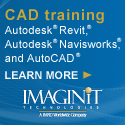
|
www.agc.org Contact Us Archives/Subscribe Advertise IT Forum IT Forum Steering Committee |
Behind-the-Scenes SpotlightAs evidenced by the RFI demonstration that took place at AGC of America's 95th Annual Convention in March, the agcXML initiative takes dedication, hard work and commitment. And, as it picks up steam and adds more schemata to its platform, the behind-the-scene activity will increase as well. This is the first of a series of interviews, highlighting the importance of agcXML and the folks working to make it happen. Q&A with Angus Frost Burger Consulting Group Q: Please provide career information for yourself. I’d had a variety of roles over a 25+ year career, all focused on how to make the best use of technology to support the business objectives of an organization. I’ve worked as chief information officer and management consultant in the construction industry for the past 13 years, helping the senior executives of companies both large and small figure out how to best use their technology investment. I’d describe myself as a practical technologist, meaning that I don’t just love technology for technology's sake.
Q: Describe agcXML as if you were speaking to a non-computer person. When you send an email to someone, you don’t worry about which email system they use, you just send it. You can send attachments too and you know that even if you are using Outlook and they are using Yahoo or Gmail, they will still be able to read the email and get the attachments. This works because behind the scenes, email systems support and understand a standard for sending email. It’s called SMTP (Simple Mail Transport Protocol). Although it supports more functionality, the agcXML interoperability standard can be thought of as the SMTP equivalent for sending construction-related information between construction software systems.
Q: Why did your company choose to become involved in the agcXML initiative?
I’ve seen the value of standards used in other industries to send information between different software systems. They exist in manufacturing, finance, travel and education (to name a few) and support interoperability between the different software systems used in those industries. Ever since I began working in the construction industry I’ve been looking for something similar. I’ve seen so many companies struggling with the challenges of exchanging data both internally within their four walls as well as externally with other project specific participants that the value of a standard was clear. I see my role as a management consultant in the industry to be the contractor advocate with software vendors. With my technology background and experience of other standards becoming involved,developing a data interoperability standard for the construction industry was a clear way to be an advocate for Burger Consulting Group’s customers and for the industry as a whole.
Q: How long have you been working on agcXML?
Christian Burger and I have been working with AGC for over four years to help them re-energize the agcXML project which had stalled back in 2009. I was able to bring my experience in other industries with data interoperability standards to help develop a path forward for agcXML.
Q: How do you see agcXML transforming the industry? I’ll give you my top three opportunities for the industry:
Q: What additional steps do you feel should be taken to spur adoption? What can others, outside of the agcXML team, be doing to ensure agcXML becomes an industry reality?
The agcXML interoperability standard defines a series of business processes that can be adopted as a whole or individually. The advantage of this approach is that benefits of adoption can be accomplished in a variety of ways. Initial adoption can be achieved by getting either a large number of software vendors to support one or more agcXML interoperability processes (e.g. RFIs and change orders) in their products, or a smaller group of vendors supporting agcXML over a large number of projects. Adoption will take a combination of owners and contractors demanding the use of agcXML on projects and more software vendors joining the initial group that is supporting it. We have several software vendors already supporting it and now we as an industry need to collectively demand that all of the software vendors that we use support the standard.
Q: Describe your role in the RFI data exchange demo at convention. In my role as the chief architect for the agcXML initiative, my job was to work with all of the software vendors participating in the demo to make sure that they had what they needed to implement agcXML in their products. Outside of the demo I oversee the general direction of the development of agcXML. I help provide context to construction industry processes to the developer of agcXML to help them with the design. I also work with software vendors to promote the use of agcXML and to solicit their feedback in the development of the standard so that we can ensure that it facilitates adoption. My role is a combination of agcXML evangelist and steward to the initiative.
Q: How do you feel the audience reacted to the data exchange demonstration? As an observer of the event I was laughing to myself a bit. The audience was impressed by the demo, seeing data flow between disparate systems without reentry was impressive to them, but it also happened so smoothly that it probably seemed fairly uneventful. We had four software vendors exchanging information as smoothly as if they had always been doing it. I think because it looked so easy the true momentous impact of what was accomplished by using the standard was not fully appreciated. It was an industry-changing event, but I think is retrospect, perhaps we made it look too easy!
Q: Were there questions raised by audience members that hadn’t been addressed by the agcXML team? If so, what were they and will they be addressed in the future? I facilitated a panel discussion with the software vendors after the demonstration asking questions provided by the audience. The questions were focused more on getting additional clarification on aspects of agcXML than the identification of something that we hadn’t already thought of. Obviously one of the biggest questions is when will it be available and having two of the software vendors indicate they will have support for it in their product this year is fantastic news for the industry.
As a point of note, we are going to make all of the questions and the answers available via the agcXML .org website site soon Q: What do you see as the biggest obstacle for this initiative? When talking to software vendors about how to get them to support agcXML, for those that are reluctant to build support for it in their products, one of the most common responses is that their customers aren’t asking for it. That may be because their customers were not aware of agcXML or what it did in order to be able to ask for it. So educating the industry on what agcXML is and why it is important is I think the biggest obstacle at the moment. Once we have enough of the industry educated, they will know what to ask for from their software vendors and create that industry demand.
Q: What do AGC members need to do to begin using agcXML for my projects?
The first software products with support for agcXML built in are likely to appear in the second or third quarter of this year. Currently we are getting ready to conduct a public review of the initial business processes supported by the agcXML interoperability standard. What this means is that we will be soliciting feedback from as many industry software vendors as possible on agcXML. This is their opportunity to submit any questions about how to implement it in their product or request amendments to make it easier to implement. If you want to be able to use agcXML on your projects you need to make sure that you ask your software vendor(s) to participate in the public review and then demand that they support agcXML in their product as soon as possible. Q&A with John Goecke StratusVue Q: Please provide career information for yourself. With 29 years' experience in construction-related document management, I have worked in all facets of managing projects and developing processes related to the industry. I have been with StratusVue since its inception and have focused on the migration from paper to electronic workflows. In the 13 years since the original launch of PlansandSpecs, documents and workflow for more than 12,000 projects have been managed in the cloud. In 2011, activity surpassed more than 40,000 unique visitors and project documents accessed from 65 different countries. Notable projects run through PlansandSpecs include the Aqua in Chicago; a mixed-use, 80-story high rise that won "Sky Scraper of the Year" in 2009 and Parkview Regional Medical Center in Fort Wayne, Ind., with each project engaging more than 400 project members spanning multiple countries.
For 17 years, I was the executive vice president of FXWB, a Chicago-based print and distribution company where PlansandSpecs was created. While he was at FXWB, the company expanded to four locations and more than quadrupled in revenue. In 2001, PlansandSpecs was released to complement digital asset management. In 2007, PlansandSpecs became independent of all printing-related services and introduced the paperless workflow that has evolved to what is offered today. In July of 2013 the new brand of StratusVue was implemented incorporating the previous product lines and the new BidVue tools and the patent pending BIMfx.
Q: Describe agcXML as if you were speaking to a non-computer person. agcXML enables computer programs to speak to each other. In most corporate environments similar data needs to be entered into multiple systems. Imagine if every time you started a project you didn’t have to open new files name "Project X" in six different places ~ That’s agcXML.
Q: Why did your company choose to become involved in the agcXML initiative? To further adoption of new technology. Working in the cloud is disruptive to most IT departments and creates resistance to adoption. By creating pass through linking of workflow – all levels gain a sense of security in better use and adoption of more modern methods.
Q: How do you see agcXML transforming the industry? I see it being both disruptive and supportive to the industry. agcXML as a baseline requirement to software standards is a giant step toward interoperability.
Q: What additional steps do you feel should be taken to spur adoption? I think a vendor- and association-neutral clearing house will establish trust in transactional interchanges among software vendors.
Q: What can others, outside of the agcXML team, be doing to ensure agcXML becomes an industry reality? Mandate to your software vendor companies that they have a specific period of time to be compliant – one year – 18 months – two years – or face loss of contractual support
Q: How do you feel the audience reacted to the data exchange demonstration? I thought there was genuine support and surprise at the effectiveness of the demo. I think they started seeing many different avenues to integrate.
Q: What do you see as the biggest obstacle for this initiative?
|

2300 Wilson Boulevard, Suite 300 · Arlington, VA 22201 · 703-548-3118 (phone) · 703-548-3119 (fax) · www.agc.org
About AGC | Advocacy | Industry Topics | Programs and Events | Career Development | News & Media
© Copyright 2025 The Associated General Contractors of America. All rights reserved.

